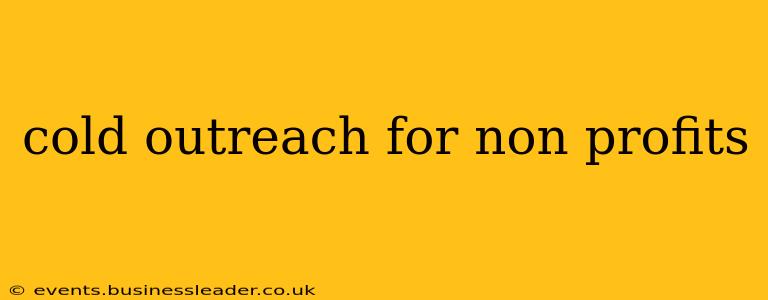Cold outreach can be daunting, but for nonprofits, it's often a crucial strategy for securing funding, building partnerships, and expanding their impact. This guide provides a comprehensive approach to effectively reach out to potential donors, collaborators, and volunteers, focusing on building genuine connections and achieving sustainable results.
What is Cold Outreach for Nonprofits?
Cold outreach for nonprofits involves proactively contacting individuals or organizations who haven't previously expressed interest in your cause. This could include reaching out to potential donors, corporate sponsors, volunteers, or even media outlets to raise awareness and garner support. Unlike warm outreach (contacting people already familiar with your work), cold outreach requires a strategic and persuasive approach to capture attention and build rapport quickly.
How to Craft Effective Cold Outreach Emails
The key to successful cold outreach lies in crafting compelling and personalized emails. Avoid generic templates; instead, tailor your message to the specific recipient. Here’s a framework:
-
Personalized Subject Line: Don't use generic subject lines like "Donation Request." Instead, try something specific and attention-grabbing related to the recipient's interests or your organization's mission. For example, "Supporting [Recipient's Interest] Through [Your Organization's Mission]".
-
Compelling Introduction: Start with a strong opening that immediately grabs attention. Mention something specific you know about the recipient or their organization to show you've done your research. Avoid generic greetings like "To whom it may concern."
-
Highlight the Problem and Your Solution: Briefly explain the issue your nonprofit addresses and how your organization provides a solution. Use data and impactful storytelling to illustrate the need.
-
Clearly State Your Ask: Be direct about what you're requesting – whether it's a donation, partnership, volunteer support, or media coverage. Make it easy for the recipient to understand how they can help.
-
Include a Call to Action (CTA): Make it easy for the recipient to respond. Provide a clear and concise call to action, such as a link to your website, a phone number, or a scheduling link for a call.
-
Professional Closing: End with a professional closing, reiterating your appreciation for their time and consideration.
What are the Best Practices for Cold Outreach?
-
Research Your Target Audience: Identify potential donors, partners, or volunteers who align with your mission and have the capacity to contribute.
-
Segment Your List: Group your contacts based on their potential to contribute, their interests, and their level of engagement. This allows for more targeted and personalized outreach.
-
Track Your Results: Monitor your outreach efforts to determine what works and what doesn't. Analyze open rates, click-through rates, and conversion rates to refine your strategy.
-
Personalize Your Message: Avoid generic templates. Use the recipient's name and reference their interests or past actions.
-
Follow Up: Don't be discouraged by a lack of immediate response. Follow up with a polite and persistent approach. Sometimes, a second or third email is needed to capture attention.
-
Build Relationships: Cold outreach is about more than just securing immediate results. Focus on building long-term relationships with potential supporters.
What are Some Common Mistakes to Avoid?
-
Generic Emails: Avoid sending mass emails that aren't personalized.
-
Ignoring the Recipient's Time: Keep your email concise and to the point.
-
Lack of Follow-Up: Consistent follow-up is crucial for success.
-
Not Providing Enough Information: Make sure to clearly explain your organization's mission and impact.
-
Asking for Too Much Too Soon: Start with smaller asks and build trust over time.
How Can I Find Potential Contacts for Cold Outreach?
-
Online Research: Use LinkedIn, social media, and other online resources to identify potential donors, partners, and volunteers.
-
Networking Events: Attend industry events and conferences to connect with potential supporters.
-
Referrals: Ask your existing network for referrals to potential contacts.
How can I measure the success of my cold outreach campaign?
Measuring success requires tracking key metrics. Consider these:
- Open Rates: How many recipients opened your email?
- Click-Through Rates: How many recipients clicked on the links in your email?
- Conversion Rates: How many recipients took the desired action (e.g., made a donation, scheduled a meeting)?
- Donations Received: Track the amount of donations received as a direct result of the campaign.
- Partnerships Secured: Count the number of successful partnerships formed.
- Volunteer Sign-ups: Track the number of volunteers who signed up as a result of your outreach.
By implementing these strategies and consistently refining your approach, your nonprofit can leverage the power of cold outreach to achieve its goals and make a significant impact. Remember, genuine connection and a clear understanding of your audience are key to successful cold outreach.
